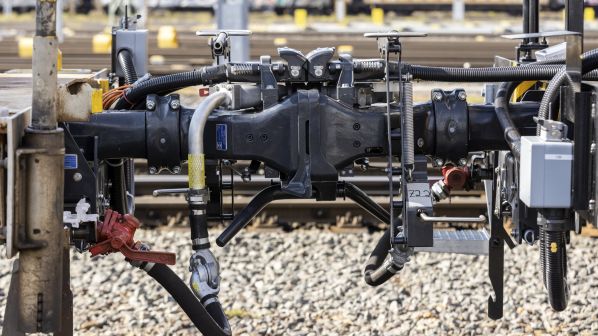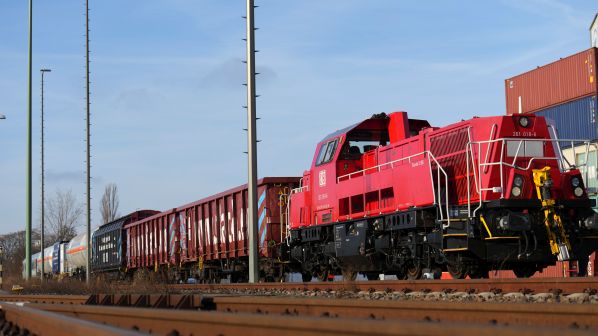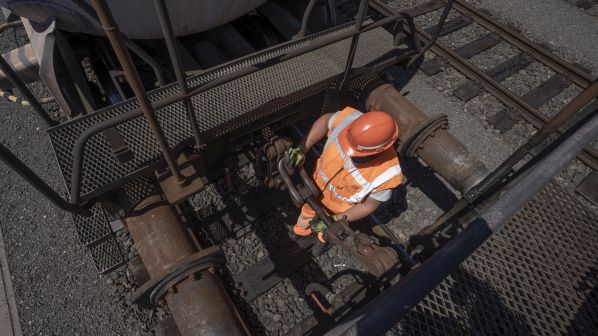AS traction, signalling and maintenance systems have all advanced, the humble screw coupler remains the standard across Europe. First introduced more than 100 years ago, the coupler still requires a staff member to climb between wagons to manually couple and uncouple them. Staff at DB Cargo, Europe’s largest rail freight operator, complete this process 70,000 times a day. But this is about to change with the development of the Digital Automatic Coupler (DAC).
SBB Cargo launched its four-year 5L demonstrator train research project to test a number of components such as bogies and wheelsets in June 2018, which included DACs from Voith and Faiveley, which has since been acquired by Wabtec. Voith proposed a coupler based on its Scharfenberg coupler, while Faiveley’s prototype was based on the Schwab type coupler.
The 5L demonstrator was one of three wider projects implemented by members of the Technical Innovation Circle for Rail Freight Transport (TIS), which also included the Innovative Freight Wagon developed by German Rail (DB) and VTG.
The work undertaken under the 5L project and other TIS projects fed into the work launched under the Shift2Rail (S2R) joint venture, which included the development of DAC under its Innovation Programme 5 to improve freight services.
The Digital Automatic Coupling for Europe (DAC4EU) project, funded by Germany’s Federal Ministry for Digitalisation and Transport (BMVI), was also launched in mid-2020 to test various automatic couplers. Six companies from Germany, Austria, Switzerland and France were awarded a contract by BMVI to conduct a research project entitled “DAC Demonstrator for Rail Freight Traffic.” The DAC4EU consortium comprises German Rail (DB) and its subsidiary DB Cargo, Swiss and Austrian freight operators SBB Cargo and Rail Cargo Austria, and the wagon leasers Ermewa, GATX Rail Europe and VTG.
Four suppliers provided DACs for testing under the DAC4EU programme: CAF, with the SA3 coupling head; Dellner, with the Latch-type coupling head; Faiveley, with the Schwab coupling head; and Voith, with the Scharfenberg coupling head.

Under the combined banner of the European DAC Delivery Programme (EDDP), around 100 experts from 36 companies in 2021 assessed the results from the tests undertaken through the S2R and DAC4EU programmes, and previous S2R work at the end of July 2021. Following this extensive testing, the Scharfenberg latch design was selected as the preferred European-wide DAC standard coupler head in September 2021.
“It has been a long process, and it will continue to be a long process,” says Mr Fredrik Nordström, Dellner’s corporate business development director.
However, he says this standard only covers the mechanical coupler, with work ongoing to determine the specification for the electrical coupler which provides the digital capability. Nordström says the target is to agree on an electrical coupler over the coming six to nine months.
This must be completed ahead of the launch of a demonstrator train in 2024 at the latest that will test the trensfer of energy and data between wagons.
“That means that we need to close these electric coupler designs within 2022, do any final internal design, produce couplers with both electrical and mechanical couplers, testing and then mounting them on wagons,” he says.
Voith’s vice-president, couplers, Mr Christian Radewagen, says they were able to draw on their experience gathered during the tests and commercial operation conducted with SBB Cargo to improve the DAC during the tests with the DAC4EU programme.

“As soon as we start to standardise it down to a screw ..... then there is no room for innovation. But if we focus only on the necessary interfaces, for sure there is room for innovation.”
Christian Radewagen
One issue that had to be overcome was the need for the coupler to work under harsh winter conditions.
“Before it was said that Scharfenberg couplers were not able to perform under winter conditions, especially not without heating. And you cannot heat 100 couplers in a freight train because the energy is not sufficient enough for a 500m-long train,” Radewagen says. “This was something we focused on, and we found a solution that was a special plate contour shape. Swedish winter tests confirmed that the Scharfenberg will perform well under snow and ice conditions. This was also confirmed by tests in the climate chamber of DB.”
Radewagen says this ability to operate under any condition was a major factor in the selection of the Scharfenberg latch design as the European-wide DAC standard coupler.
Nordström says Dellner’s process of developing the DAC to its current state has been based on the rapid prototyping, where a prototype is built, tested and refined. This was constantly compared with the requirements and specifications set for the couplers.
“Since 2019, we have tested roughly three generations,” he says. “You normally do one generation every 12 months. It has been a rapid process internally with a number of tests, feedback, upgrades, discussions of specification, and then harmonisation with the other suppliers to be able to reach a common base design.”
The number of partners involved in the various development projects has required a high level of collaboration across the industry, while suppliers have also been keen to retain their intellectual property rights (IPR).
“You need to have your IPRs, you need to take care of your own ideas,” Nordström says. “But at the same time, you have to remember that we need to reach a common specification because in the end, these couplers must be interoperable. It doesn’t matter who is coupling to whom, we need to find the important interface.”
Benefits
The advantages of using a DAC go further than the most obvious benefit of reducing the manual labour required when forming a train.
Wabtec is especially enthused by the project’s potential to support the introduction of new systems that will unlock improvements in safety and performance. “Wabtec is famous for a systems approach,” says Mr Paolo Pagliero, vice-president engineering of transit activities at Wabtec. “The coupler is just the enabler for improvements throughout the train.”
The ability to send data between wagons provides the capability to digitise operations, something that has been missing from freight operation. This allows operators to check whether brakes along the train are working, whether trains are loaded correctly, where they are located across the network and when they are expected to arrive. In addition, Wabtec envisages the locomotive being equipped with systems capability of pinpointing a specific wagon for remote uncoupling from the train, revolutionising the train preparation and unloading process. “This opens up a cultural change for the entire freight system,” Pagliero says. The new systems will also help to improve braking performance by enabling simultaneously EP and EPC braking of all wagons. This will reduce stopping distances as well as improving the distribution of longitudinal forces along the train and performance in curves, limiting the wear on wheelsets, brakes and bogies, reducing costs and maintenance requirements.

“You need to have low prices, robust functionality and low maintenance. So the challenge has been to come up with a robust design at the correct price.”
Fredrik Nordström
Other functions such as surveillance of high value goods, telematics and goods monitoring, can contribute to the data gathering process necessary for condition-based maintenance regimes for all manner of components, again helping to reduce operating costs.
A demonstrator test train equipped with the standardised DAC departed Berlin in January under the DAC4EU programme to conduct several months of tests across Europe. The train first ran through Germany and Austria to Switzerland, from where it will run to other EU countries until the end of the year. The tests will trial the DAC in situations that are not common in Germany, including steep inclines, sharper curves or different climatic conditions.
This will be followed in 2024 or 2025 by a test train that will be equipped with the completed DAC to allow the system to be fully tested in an operational environment instead of only test conditions.
Specifications
The work to this point has focused on setting the specification for the interface which will allow couplers manufactured by different suppliers to connect with each other, while still leaving room for innovation in the digital systems. Radewagen says the level of innovation will depend on the amount of standardisation.
“As soon as we start to standardise it down to a screw because the operators want to keep a very low spare part stock, then there is no room for innovation,” he says. “But if we focus only on the necessary interfaces, for sure there is room for innovation.”
He points to remote uncoupling as an example. Couplers are categorised into five types depending on functionality. The DAC currently being tested across Europe is a Type 4, which allows the automatic coupling of mechanical, pneumatic, power and data systems, but doesn’t include automatic uncoupling, which is provided by the Type 5. Radewagen says the Type 4 is preferred for the standard due to the variety of national rules across Europe. However, it could be possible for individual suppliers to offer a Type 5 DAC that is compatible with the Type 4 DAC.
“In Europe, there are different operational rules as the operators are focusing on their special areas and nations, and it seems that the initial target is to have a manual uncoupling function,” he says. “The industry says this fully remote uncoupling will not be developed and approved until migration has started. It is too complicated having the certification of all the necessary safety rules.”
Radewagen says it is possible to introduce an intermediate step, where the uncoupling mechanism is activated by a button on the side of the wagon, ahead of it becoming automated, which has already been successfully demonstrated during tests in Austria and Sweden.
Wagon owners, operators and infrastructure managers have also called for different functionalities, which have had to be accounted for when developing the standard DAC.
“You come up with a solution and then someone says we would like to do it like this or that functionality,” Nordström says. “But at the same time you need to have low prices, robust functionality and low maintenance. So the challenge has been to come up with a robust design at the correct price.”
This price point is important, as the coupler will need to be rolled out on between 450,000 and 500,000 wagons across Europe, with two per wagon. Between 17,000 and 20,000 locomotives must also be equipped. Indicative figures from the EDDP show that purchasing the equipment for the wagons and locomotives is expected to cost between €7.6bn and €8.9bn, while labour costs could reach €1.5-1.6bn, leading to a total project cost of €9.1-10.5bn, although these figures remain under assessment.
There is still debate over who should be responsible for shouldering this cost. If it is left to the wagon owners, it could increase the time it takes to implement DAC across the continent, which would have a knock-on effect on freight flows and interoperability, causing issues for freight customers. If the European Union (EU) mandates a shorter implementation period, then the wagon owners and operators could call for public funding to meet the deadline.
Implementation
Financial considerations aside, there are also questions around the supply sector’s ability to manufacture and install the hundreds of thousands of DAC required in a timely manner, which Nordström concedes is “a huge challenge” but one he believes the sector is prepared for.
“What the EU have tried to do is to investigate how many workshops we have, how many depots are there across Europe, and how all of these can be used to as fast as possible work through all these wagons,” Nordström says. “It will be a conversation between the wagon owners, the maintainers and us as the coupler producers, [to see] how we can best use the different depots that we have, how we can implement the supply chain for all the couplers, and how can we train the depot personnel to change the couplers. And then we can have a rolling process where every time a wagon comes into the depot you change the couplers. It needs to be a joint effort for this one.”

Photo: DB/Oliver Lang
This is echoed by Radewagen, who says many suppliers are preparing to increase capacity to meet the expected demand. However, he says there needs to be guidance from a European level that will guarantee the migration will go ahead as planned, to ensure this major investment in development and manufacturing capability provides a return.
Nordström reiterated the need for regulatory steering from the European Commission to prevent country-specific regulations from hindering the rollout of DAC across Europe.
Several alternative strategies are under consideration to achieve a seamless rollout. Prime among them is a two-stage approach that would involve installing the rear draft gear for the coupler on the wagon during regular maintenance. To do this, the wagon must be jacked and the bogies removed before the back half of the coupler is installed. The bogie is then replaced, and the screw coupler reinstalled to allow it to continue in normal operation.
Following the “big bang” decision to switch to DAC in full operation, the screw coupler can then be removed and the front half of the DAC connected to the previously installed draft gear.
“You can do that without using a pit and you don’t need to dismount the bogies, you can more or less do it outside of a workshop as long as you have straight track and lifting equipment for around 100kg,” Nordström says. “Doing this in two steps will increase the chances of completing the migration within two or three years.”
Another option could be to create “married pairs” - two wagons coupled with a DAC with a screw coupler at either end. While this would allow half of the installation to be completed before requiring a migration to full DAC, Nordström says this can cause issues when you want to operate individual wagons on different services.
“Wabtec is famous for a systems approach. The coupler is just the enabler for improvements throughout the train.”
Paolo Pagliero, vice-president engineering of transit activities at Wabtec.
Installation of the DAC generally takes between half an hour to an hour, but this can take longer depending on the condition of the wagon.
Developing a DAC for the locomotives is much more complex, as it must be designed as a “loco hybrid coupler” to allow the operator to switch between the DAC and screw coupler depending on what is needed. The coupler must also be integrated with the locomotive body, as the forces are directed straight into the locomotive and not through the buffers as with the screw coupler. However, this dual interface simplifies the rollout of the DAC to the locomotives, as there is no transition period.
The EDDP has outlined an indicative overall timescale, which foresees a development phase between 2021 and 2025, followed by a deployment phase from 2026 to 2030 which includes procurement, with the “big bang” implementation launch around 2027-2029. However, DB Cargo could look to begin installing DACs on its fleet in 2025.
“They said we need to start somewhere around 2025,” Radewagen says. “If we wait too long to have the technical readiness and the production volume available, this window might close for later migration. Therefore, there’s a big focus to achieve the target being prepared for a start in 2025 and so the focus of the sector, the suppliers and the customers is to speed up the definition and development process.”
The European rail sector has been notoriously slow to rollout other technologies designed to harmonise operation, with ERTMS the chief culprit. This cannot be the case with the delivery of DAC. Operating two coupling systems across Europe unnecessarily would cause unneeded disruption to a sector that must do all it can to attract new customers. The collaboration seen during the testing and development stages is encouraging and must continue if we are to see the end of the 100-year-old screw coupler in Europe.

